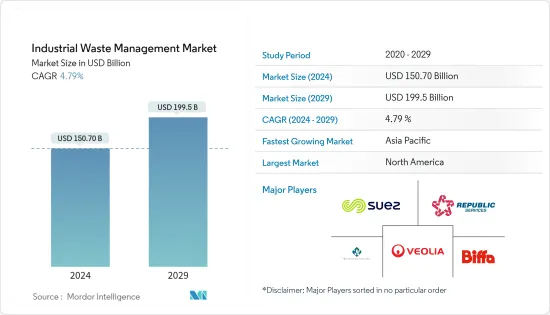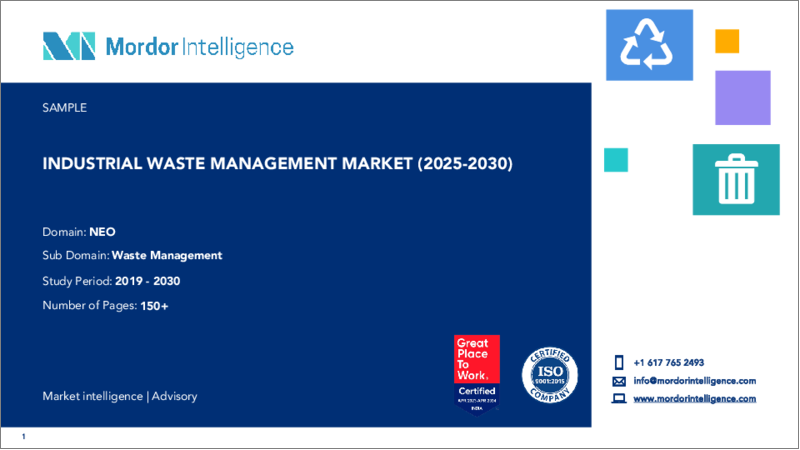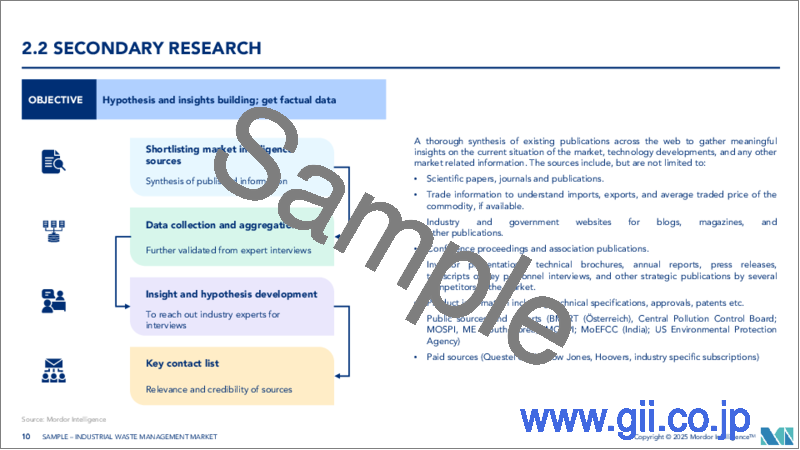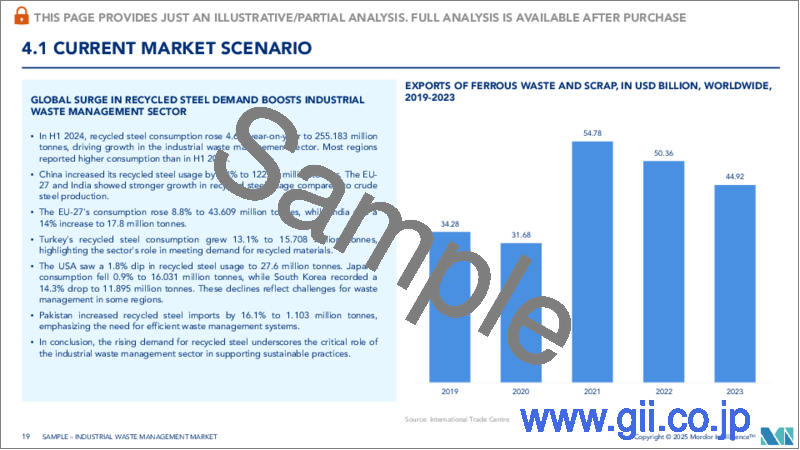|
|
市場調査レポート
商品コード
1521743
産業廃棄物管理:市場シェア分析、産業動向と統計、成長予測(2024年~2029年)Industrial Waste Management - Market Share Analysis, Industry Trends & Statistics, Growth Forecasts (2024 - 2029) |
||||||
カスタマイズ可能
適宜更新あり
|
|||||||
| 産業廃棄物管理:市場シェア分析、産業動向と統計、成長予測(2024年~2029年) |
|
出版日: 2024年07月15日
発行: Mordor Intelligence
ページ情報: 英文 120 Pages
納期: 2~3営業日
|
全表示
- 概要
- 目次
産業廃棄物管理の市場規模は2024年に1,507億米ドルと推定され、2029年には1,995億米ドルに達すると予測され、予測期間中(2024-2029年)のCAGRは4.79%で成長すると予測されます。

廃棄物管理業務、データ分析、機械学習は、産業界でますます適用されるようになっています。予測分析は、廃棄物の流れの発生動向を予測し、自治体や廃棄物管理会社の資源配分を支援します。Greyparrotは廃棄物管理市場で信頼されるソリューションです。廃棄物管理の透明性と自動化を高めることで、GreyparrotのAI廃棄物分析プラットフォームは、循環型経済諸国開発の最前線にいます。
使い捨てプラスチックや非分解性包装材料の拡散は、廃棄物管理における大きな課題のひとつです。この問題に取り組むため、革新的な包装ソリューションが開発されています。生分解性や堆肥化可能な素材は、従来のプラスチックに取って代わり、包装廃棄物が環境に与える影響を軽減するために開発されています。2023年5月、ボレアリス社は、95%以上がポリプロピレンであると言われる、リサイクル用に特別に設計された単一素材のパウチを発表しました。このパウチは乾燥食品を包装するためのもので、拡大生産者責任(EPR)プログラムのエコモジュレーション基準を満たすことを目的としています。
ロボットシステムは、リサイクルプロセスの合理化において重要な役割を担っています。これらのロボットは、驚くべき正確さとスピードでリサイクル可能な材料を識別し、選別することができます。リサイクル施設は、選別プロセスを自動化することで、業務の効率を高め、リサイクル原料の汚染を減らすことができます。2023年4月、イタリアの廃棄物管理会社Il SolcoはRecycleyeと提携し、世界中の廃棄物管理業界に人工知能ロボットを導入する意向です。
産業廃棄物管理市場の動向
アジアにおける産業廃棄物管理の需要拡大が予想される
アジア太平洋の東部と南部では、産業の急速な発展と経済成長により、生産と産業活動の増加が見込まれています。産業廃棄物の生産量は通常、その分野の成長に比例します。
産業廃棄物の増加は、繊維、化学、電子機器などの製造業の発展によるものです。生産過程において、繊維や化学のようなセクターは、かなりの量の廃棄物を発生させる可能性があります。2023年11月、カンボジアの非営利団体LICADHOは、ブランドから出るゴム、生地、プラスチックなどを含む消費者以前の衣料廃棄物が7つの工場で焼却されていると報告しました。燃料費を節約するため、工場は生産現場から出る廃棄物を燃やしており、労働者に頭痛や呼吸器系の問題を引き起こしていました。
急速な技術革新は、古い技術がもはや意味をなさなくなり、電子廃棄物の発生にもつながるかもしれないです。アジア諸国が新技術を採用することにより、廃棄物の発生が増加する可能性があります。業界の専門家によると、アジア太平洋地域のAI支出は、AIに特化したシステムのサービス、ソフトウェア、ハードウェアを含め、2027年には784億米ドルに達すると予想されています。
モノのインターネットは廃棄物管理の未来
廃棄物容器の管理方法によって、廃棄物の蓄積と処理は都市部にとって大きな問題となっています。新技術は、こうした課題に対処する画期的な解決策であり、効率的な方法であることが証明されつつあります。例えば、無線センサーネットワーク(WSN)やモノのインターネット(IoT)技術は、廃棄物容器の管理に利用されています。
ブロードコムと共同で開発されたラズベリー・パイは、Linuxを実行できる手頃な価格のコンピューターです。GPIO(汎用入出力)ピンを搭載しており、物理コンピューティング用の電子部品とのインターフェースを可能にし、モノのインターネット(IoT)の領域に踏み込むことができます。ラズベリーパイは、廃棄物を管理する国々が採用できる産業で使用されています。
スマート廃棄物管理(SWM)には、スマートごみ箱(SGB)に設置されたセンサーからのデータ収集と分析、廃棄物トラックと都市インフラの連携、廃棄物トラックルートの戦略的計画と最適化が含まれます。包括的なリアルタイムの視点を提供するため、SWMシステムは、内部プロセスを改善するものと情報を配信するもの2つに分類することができます。いくつかの研究では、SWMシステムの経済的・環境的メリットが示唆されています。
IoTもまた、経済に大きな影響を与えることになると思われます。専門家によると、モノのインターネットは2025年までに年間11兆1,000億米ドルを生み出す可能性があるといいます。
産業廃棄物管理業界の概要
産業廃棄物管理市場は適度に細分化され競合が激しく、複数の大手企業が中堅・中小企業と戦略的に提携し、物流における地域能力を活用しています。主要企業は、産業廃棄物の効率的な処理、治療、処分のための包括的なソリューションの提供に取り組んでいます。一部の企業は、有害廃棄物処理、電子廃棄物リサイクル、エネルギー回収など、産業廃棄物管理の特定の側面に焦点を当てています。これらの専門サービス・プロバイダーは、独自の廃棄物管理要件を持つ産業に対応しています。Waste Management社、Veolia Environnement社、SUEZ社などの著名な企業は、産業廃棄物管理の世界的リーダーです。これらの企業は大規模に事業を展開し、産業界の顧客に幅広い廃棄物管理サービスを提供しています。
その他の特典
- エクセル形式の市場予測(ME)シート
- 3ヶ月間のアナリスト・サポート
目次
第1章 イントロダクション
- 調査の成果
- 調査の前提
- 調査範囲
第2章 調査手法
第3章 エグゼクティブサマリー
第4章 市場洞察
- 現在の市場シナリオ
- 技術動向
- 業界のバリューチェーン分析
- 政府の規制と取り組み
第5章 市場力学
- 促進要因
- 厳しい環境規制
- 持続可能性への意識の高まり
- 抑制要因
- 高い初期設備投資
- 複雑な規制状況
- 機会
- 技術の進歩とデジタル化
- 業界の魅力- ポーターのファイブフォース分析
- 供給企業の交渉力
- 消費者/買い手の交渉力
- 新規参入業者の脅威
- 代替品の脅威
- 競争企業間の敵対関係の強さ
第6章 市場セグメンテーション
- 処理方法別
- 埋立処分
- 焼却
- リサイクル
- タイプ別
- 有害
- 非有害
- 地域別
- 北米
- 米国
- カナダ
- 欧州
- 英国
- ドイツ
- フランス
- ロシア
- その他欧州
- アジア太平洋
- 中国
- 日本
- インド
- 韓国
- その他アジア太平洋地域
- 中東・アフリカ
- ラテンアメリカ
- 北米
第7章 競合情勢
- 企業プロファイル
- Veolia Environnement SA
- Suez Environment SA
- Republic Services Inc.
- Waste Connections
- Waste Management Inc.
- Remondis AG & Co. Kg
- Biffa Group
- Clean Harbors Inc.
- Covanta Holding Corporation
- Daiseki Co. Ltd*
第8章 市場機会と今後の動向
第9章 付録
The Industrial Waste Management Market size is estimated at USD 150.70 billion in 2024, and is expected to reach USD 199.5 billion by 2029, growing at a CAGR of 4.79% during the forecast period (2024-2029).

Waste management operations, data analysis, and machine learning are being applied increasingly in industries. Predictive analytics can forecast trends in the generation of waste streams to help municipalities and waste management companies allocate resources. Greyparrot is a trusted solution in the waste management market. By increasing translucency and automation in waste management, Greyparrot's AI waste analytics platform is at the forefront of circular economy development.
The proliferation of single-use plastics and nondegradable packaging materials is one of the major challenges in managing waste. Innovative packaging solutions are being developed to tackle this problem. Biodegradable and compostable materials are being developed to replace traditional plastics and reduce the environmental impact of packaging waste. In May 2023, Borealis introduced a mono-material pouch specifically designed for recycling that is said to represent more than 95% polypropylene. The pouch is intended to pack dry food products and aims to meet the eco-modulation criteria for extended producer responsibility (EPR) programs.
Robotic systems have a key role to play in streamlining the recycling process. These robots can identify and sort recyclable materials with remarkable accuracy and speed. Recycling facilities can increase the efficiency of their operations and reduce the contamination of recycled materials by automation of the sorting process. In April 2023, Il Solco, an Italian waste management company, partnered with Recycleye, intending to introduce artificial intelligence robotics in the waste management industry worldwide.
Industrial Waste Management Market Trends
A Growing Demand for Industrial Waste Management is Anticipated in Asia
Increased production and industrial activity can be expected in the East and South of Asia-Pacific due to rapidly developing industries and economic growth. The production of industrial waste is usually proportional to the growth of the sector.
Increased production of waste from industry is a result of the development of manufacturing industries such as textiles, chemicals, and electronics. During the production process, sectors such as textiles and chemicals may generate a significant amount of waste. In November 2023, LICADHO, a non-profit organization in Cambodia, reported that pre-consumer garment waste, including rubber, fabric, plastic, and other materials from the brands, was being burned at seven factories. To save fuel costs, factories burned waste from the production site, which caused headaches and respiratory problems for their workers.
Rapid technological change may also lead to the generation of electronic waste, as old technologies are no longer relevant. There may be an increase in waste generation due to the adoption of new technology by Asian countries. As per industry experts, AI spending in Asia-Pacific is expected to reach USD 78.4 billion in 2027, including services, software, and hardware for AI-focused systems.
The Internet of Things is the Future of Waste Management
Due to how waste containers are managed, the accumulation and disposal of waste have become major problems for urban areas. The new technologies are proving to be a revolutionary solution and efficient way of addressing these challenges. For instance, wireless sensor network (WSN) and Internet of Things (IoT) technologies are used to manage waste containers.
The Raspberry Pi, developed in collaboration with Broadcom, is an affordable computer that can run Linux. It includes GPIO (general-purpose input/output) pins, enabling users to interface with electronic components for physical computing and delve into the realm of the Internet of Things (IoT). The Raspberry Pi is used in industries where it can be adopted by countries managing waste.
Smart waste management (SWM) encompasses the gathering and analysis of data from sensors installed on smart garbage bins (SGBs), the coordination of waste trucks and urban infrastructure, and the strategic planning and optimization of waste truck routes. To provide a comprehensive real-time perspective, SWM systems can be grouped into two categories, i.e., those that improve internal processes and those that distribute information. Several studies have suggested the economic and environmental benefits of SWM systems.
IoT is also set to have a significant impact on the economy. According to experts, the Internet of Things could create USD 11.1 trillion a year by 2025.
Industrial Waste Management Industry Overview
The industrial waste management market is moderately fragmented and competitive, with several large companies strategically forming alliances with mid-sized or small-sized companies to leverage their regional capabilities in logistics. Key players are engaged in offering comprehensive solutions for the efficient handling, treatment, and disposal of industrial waste. Certain companies focus on specific aspects of industrial waste management, such as hazardous waste disposal, electronic waste recycling, or energy recovery. These specialized service providers cater to industries with unique waste management requirements. Prominent companies such as Waste Management, Veolia Environnement, and SUEZ are global leaders in industrial waste management. These companies operate on a large scale, providing a wide range of waste management services to industrial clients.
Additional Benefits:
- The market estimate (ME) sheet in Excel format
- 3 months of analyst support
TABLE OF CONTENTS
1 INTRODUCTION
- 1.1 Study Deliverables
- 1.2 Study Assumptions
- 1.3 Scope of the Study
2 RESEARCH METHODOLOGY
3 EXECUTIVE SUMMARY
4 MARKET INSIGHTS
- 4.1 Current Market Scenario
- 4.2 Technological Trends
- 4.3 Industry Value Chain Analysis
- 4.4 Government Regulations and Initiatives
5 MARKET DYNAMICS
- 5.1 Drivers
- 5.1.1 Stringent Environmental Regulations
- 5.1.2 Growing Awareness of Sustainability
- 5.2 Restraints
- 5.2.1 High Initial Capital Investment
- 5.2.2 Complex Regulatory Landscape
- 5.3 Opportunities
- 5.3.1 Technological Advancements and Digitalization
- 5.4 Industry Attractiveness - Porter's Five Forces Analysis
- 5.4.1 Bargaining Power of Suppliers
- 5.4.2 Bargaining Power of Consumers / Buyers
- 5.4.3 Threat of New Entrants
- 5.4.4 Threat of Substitute Products
- 5.4.5 Intensity of Competitive Rivalry
6 MARKET SEGMENTATION
- 6.1 By Disposal Methods
- 6.1.1 Landfill
- 6.1.2 Incineration
- 6.1.3 Recycling
- 6.2 By Type
- 6.2.1 Hazardous
- 6.2.2 Non-hazardous
- 6.3 By Geography
- 6.3.1 North America
- 6.3.1.1 United States
- 6.3.1.2 Canada
- 6.3.2 Europe
- 6.3.2.1 United Kingdom
- 6.3.2.2 Germany
- 6.3.2.3 France
- 6.3.2.4 Russia
- 6.3.2.5 Rest of Europe
- 6.3.3 Asia-Pacific
- 6.3.3.1 China
- 6.3.3.2 Japan
- 6.3.3.3 India
- 6.3.3.4 South Korea
- 6.3.3.5 Rest of Asia-Pacific
- 6.3.4 Middle East and Africa
- 6.3.5 Latin America
- 6.3.1 North America
7 COMPETITIVE LANDSCAPE
- 7.1 Overview (Market Concentration and Major Players)
- 7.2 Company Profiles
- 7.2.1 Veolia Environnement SA
- 7.2.2 Suez Environment SA
- 7.2.3 Republic Services Inc.
- 7.2.4 Waste Connections
- 7.2.5 Waste Management Inc.
- 7.2.6 Remondis AG & Co. Kg
- 7.2.7 Biffa Group
- 7.2.8 Clean Harbors Inc.
- 7.2.9 Covanta Holding Corporation
- 7.2.10 Daiseki Co. Ltd*






